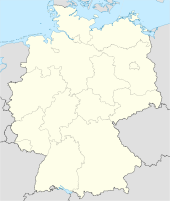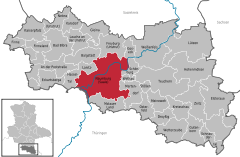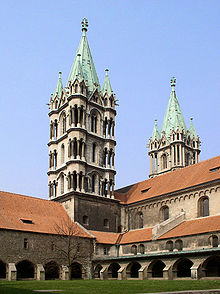- Naumburg (Saale)
-
Contents
Naumburg (Saale) 
Coordinates 51°9′N 11°49′E / 51.15°N 11.81667°ECoordinates: 51°9′N 11°49′E / 51.15°N 11.81667°E Administration Country Germany State Saxony-Anhalt District Burgenlandkreis Town subdivisions 18 Mayor Bernward Küper (CDU) Basic statistics Area 129.88 km2 (50.15 sq mi) Elevation 130 m (427 ft) Population 34,294 (31 December 2010)[1] - Density 264 /km2 (684 /sq mi) Other information Time zone CET/CEST (UTC+1/+2) Licence plate BLK Postal codes 06618, 06628 Area codes 03445, 034466, 034463 Website www.naumburg.de Bishopric of Naumburg-Zeitz
Bistum Naumburg-ZeitzState of the Holy Roman Empire ← 
1029–1565  →
→Capital Naumburg Government Principality Historical era Middle Ages - Established 1029 - Secularised to Saxony 1565 Naumburg (German pronunciation: [ˈnaʊmbʊɐ̯k]) is a town in Germany, on the Saale River. It is in the district Burgenlandkreis in the Bundesland of Saxony-Anhalt. It is approximately 60 km (37 mi) southwest of Leipzig, 50 kilometers (31 mi) south-southwest of Halle, and 40 kilometers (25 mi) north-northeast of Jena.
Local industries include the manufacture of foodstuffs, textiles, machinery and toys.
Naumburg is in a wine-growing region, with numerous vineyards in the surrounding area. SC Naumburg was a former football club in the town from September 1899 to 1908.
History
The first written record of Naumburg dates from 1012, when it was mentioned as the new castle of the Ekkehardinger, the Margrave of Meissen. It was founded at the crossing of two trade-routes. The successful foundation not long beforehand of a Propstei Church on the site of the later Naumburger Cathedral was mentioned in the Merseburg Bishops' Chronicles in 1021. In 1028 Pope John XIX gave his approval for the transfer of the bishopric from Zeitz to Naumburg. Until 1568, during the Reformation, Naumburg was the seat of the bishops. The last Catholic bishop was Julius von Pflug. The foundation of the Cathedral school is dated to 1030. Naumburg has been known as a town since 1144.
Naumburg was a significant trading centre on the Via Regia in the Middle Ages, especially because of the Naumburg Trade Fairs, first known to have taken place in 1278. The emergence of Leipzig as a trade-fair centre from 1500 and the Thirty Years' War adversely affected the Naumburg economy.
The ecclesiastical domain was secularised in middle of the 16th century and transferred to the Dukes of Saxony, who administered the district through a government endowment (Stiftsregierung) and later provided administrators.
After the fraternal competition between the four brothers of John George I, Elector of Saxony, in 1657 the Naumburger administrative area came into the possession of the secondogeniture area of Saxony-Zeitz, which the youngest son, Moritz, inherited.
Before the Moritzburg castle was built in nearby Zeitz, the Naumburger city castle served as the residence of this line. This period came to an end with the death of the last Protestant representative of the line Saxony-Zeitz in the year 1718. The Naumburger administrative area reverted to the Dukes of Saxony in Dresden and became fully integrated into Albertine Saxony. However it remained until 1815 the seat of its own administrative authority (Consistory of the district of Naumburg-Zeitz). After the Congress of Vienna in 1815, Naumburg was ceded to the Kingdom of Prussia, becoming part of the Province of Saxony. It gained control over the cathedral and its close in 1832.
In 1846 the town was connected to the rail line from Halle to Erfurt, in 1889 to Artern and eventually in 1900 to Teuchern. On 15 September 1892 a steam tram system opened in Naumburg. From 2 January 1907 it was electrified.
Although industry was only weakly developed, a socialist club was founded in 1848. During the 1920 Kapp Putsch five workers were killed. The establishment of the local Communist Party followed in December 1920. Under the German Democratic Republic Naumburg was a centre of mechanical engineering, pharmaceuticals, metal-working and footwear manufacture. It was also a garrison town for the Soviet Air Force. Unofficial estimates are that the number of Soviet military personnel approximately equalled that of the local population. The fall of communism in 1989 was accompanied by demonstrations and gatherings in the churches of the city.
Population levels':
- 1300 - ca. 3000
- 1755 - 6.987
- 1840 - 12.674
- 1875 - 16.258
- 1880 - 17.868
- 1890 - 19.807
- 1925 - 29.337
- 1933 - 31.427
- 1939 - 36.940
- 1946 - 41.379 1
- 1950 - 40.595 2
- 1960 - 37.377
- 1981 - 33.585
- 1984 - 32.610
- 1995 - 30.867
- 1997 - 30.530
- 2000 - 30.399
- 2001 - 30.388
- 2002 - 30.279
- 2003 - 29.933
- 2004 - 29.927
- 2006 - 29.521 3
1 29. October
2 31. August
3 30. JuneMain sights
The most important architectural landmark of the town is St. Peter and Paul's Cathedral (known in German as the Naumburger Dom), an impressive late Romanesque and Gothic Cathedral, built between the 13th and 15th centuries.
The early Gothic western rood screen was built in 1250. The eastern screen was added in the high Gothic style in the first half of the 14th century. The Romanesque crypt under the east gallery was established around 1170 and was part of an earlier building. Both of the towers at the east end of the church are octagonal and have Baroque canopies. The south-western spire was completed only in 1884; both western spires are closely modelled on the spires of the cathedrals of Laon and Bamberg. The pulpit dates from 1466.
Its interior includes windows from the Middle Ages, as well as the famous 13th-century statues of the founders of the cathedral, Margrave Ekkehard and his wife Uta, along with other local nobles.
The western tower has been open to the public since Easter 2007, after having long been closed for renovations.
Other attractions include:
- The late Gothic town hall (Rathaus).
- The late Renaissance residence of the Duke Moritz of Saxony-Zeitz.
- The Gothic St. Wenceslas Church, which displays paintings by Lucas Cranach the Elder and the Hildebrandt organ that Johann Sebastian Bach played on.
- The former bishop's castle Schönburg, which overlooks the town and the Saale River.
Some parts of the medieval town fortifications survive, including one of the old town gates, the Marientor.
The German philosopher Friedrich Nietzsche spent his childhood and his later years in Naumburg in the home of his mother's family. The house, known as the Nietzsche-Haus, is now a museum.
Hussite Cherry Festival
Every year on the last weekend in June, when the cherries are ripe, the city of Naumburg celebrates the Hussite Cherry Festival. This festival has a long tradition and dates back to at least the 16th century. Since the 17th century the celebrations have been connected with a supposed (but actually fictitious) siege of Naumburg by the Hussites in 1432. A teacher is said to have led his pupils outside the gates of the beleaguered town to beg the Hussite commander Andreas Prokop for mercy. The latter granted their request and gave the children cherries. The legend is commemorated in the song "Die Hussiten zogen vor Naumburg" (The Hussites marched on Naumburg) written by Karl Friedrich Seyferth in 1832.
People
- Johann Heinrich Acker
- Elias Ammerbach
- Johann Gottfried Gruber
- Christian Lobeck
- Johann Georg Graevius
- Botho Strauß
- Bishops of Naumburg
- Johannes Agricola
- Johannes Ambundii
- Nicolaus von Amsdorf
- Engelhard of Naumburg (1206–1242), see List of religious leaders in 1220
- Volquin (von Naumburg) 1209–1236, see Livonian Brothers of the Sword
- pedigree of "Naumburg"
- Friedrich Nietzsche (see above).
References
- ^ "Bevölkerung der Gemeinden nach Landkreisen" (in German). Statistisches Landesamt Sachsen-Anhalt. 31 December 2010. http://www.statistik.sachsen-anhalt.de/download/stat_berichte/6A102_hj_2010_02.pdf.
External links
Towns and municipalities in the district of Burgenlandkreis An der Poststraße | Bad Bibra | Balgstädt | Droyßig | Eckartsberga | Elsteraue | Finne | Finneland | Freyburg | Gleina | Goseck | Gutenborn | Hohenmölsen | Kaiserpfalz | Karsdorf | Kretzschau | Lanitz-Hassel-Tal | Laucha an der Unstrut | Lützen | Meineweh | Mertendorf | Molauer Land | Naumburg | Nebra | Osterfeld | Schnaudertal | Schönburg (Saale) | Stößen | Teuchern | Weißenfels | Wethau | Wetterzeube | Zeitz Categories:
Categories:- Towns in Saxony-Anhalt
- Former principalities
- Former countries in Europe
- States of the Holy Roman Empire
- States and territories established in 1029
- States and territories disestablished in 1565
- 11th-century establishments
- Burgenlandkreis
- Naumburg
Wikimedia Foundation. 2010.





